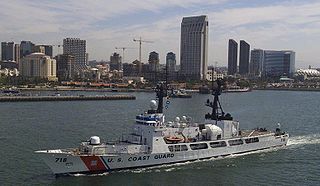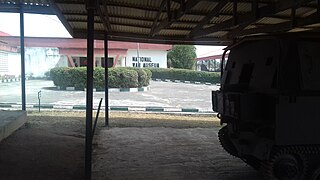
Newport News Shipbuilding (NNS), a division of Huntington Ingalls Industries, is the sole designer, builder, and refueler of aircraft carriers and one of two providers of submarines for the United States Navy. Founded as the Chesapeake Dry Dock and Construction Co. in 1886, Newport News Shipbuilding has built more than 800 ships, including both naval and commercial ships. Located in the city of Newport News, Virginia, its facilities span more than 550 acres (2.2 km2).

The Fiji-class cruisers were a class of eleven light cruisers of the Royal Navy that saw extensive service throughout the Second World War. Each ship of the class was named after a Crown colony or other constituent territory of the British Commonwealth and Empire. The class was also known as the Colony class, or Crown Colony class. Developed as more compact versions of the preceding Town-class cruisers, the last three were built to a slightly modified design and were sometimes also called the Ceylon class.

HMS Loch Insh was a Loch-class frigate of the Royal Navy, named after Loch Insh in Scotland. She was built by Henry Robb of Leith and launched on 10 May 1944. After service at the end of World War II she was decommissioned, but reactivated in 1950 and served, mostly in the Persian Gulf, until 1962. The ship was sold to the Royal Malaysian Navy in 1963 and renamed KD Hang Tuah (F433). She was scrapped in 1977.

The Daring class was a class of eleven destroyers built for the Royal Navy (RN) and Royal Australian Navy (RAN). Constructed after World War II, and entering service during the 1950s, eight ships were constructed for the RN, and three ships for the RAN. Two of the RN destroyers were subsequently sold to and served in the Peruvian Navy (MGP). A further eight ships were planned for the RN but were cancelled before construction commenced, while a fourth RAN vessel was begun but was cancelled before launch and broken up on the slipway.

LÉ Emer (P21) of the Irish Naval Service, now known as NNS Prosperityof the Nigerian Navy, was built as a patrol vessel in Verolme Dockyard, Cork, Ireland in 1977.

USS Herndon (DD-198) was a Clemson-class destroyer in the United States Navy. Herndon served in the United States Coast Guard as CG-17. She was later transferred to the Royal Navy as HMS Churchill and still later to the Soviet Navy as Deyatelny.

USCGC Chase (WHEC-718) was a Hamilton-class High Endurance Cutter of the United States Coast Guard. She was laid down on October 26, 1966, at Avondale Shipyards in New Orleans, launched on May 20, 1967, and commissioned on March 11, 1968. Chase is the fourth of twelve Hamilton class, 378-foot (115 m) cutters, and the third cutter named in honor of Salmon Portland Chase. She was decommissioned on March 29, 2011, and transferred to the Nigerian Navy as an excess defense article under the Foreign Assistance Act as NNS Thunder (F90).

ORP Krakowiak was a British Type II Hunt-class destroyer escort, used by the Polish Navy during World War II. Initially built for the Royal Navy, it bore the name of HMS Silverton during British use.

HMS Diadem was a Dido-class light cruiser of the Bellona subgroup of the Royal Navy. She was a modified Dido design with only four turrets but improved anti-aircraft armament – also known as Dido Group 2. She was built by Hawthorn Leslie and Company at Hebburn-on-Tyne, UK, with the keel being laid down on 15 December 1939. She was launched on 26 August 1942, and completed on 6 January 1944.

The Belgian Navy, officially the Naval Component of the Belgian Armed Forces, is the naval service of Belgium.

NNS Okpabana is a Hamilton-class high endurance cutter which formerly served with the U.S. Coast Guard as USCGC Gallatin (WHEC-721). Built at Avondale Shipyards near New Orleans, Louisiana, Gallatin was named for Albert Gallatin, the fourth and longest serving United States Secretary of the Treasury. Gallatin completed her final patrol 11 December 2013 and was decommissioned in 2014 before being transferred to the Nigerian Navy.

The Ford-class seaward defence boats were built for the Royal Navy in the 1950s.

HMS Truncheon was a group three T Class submarine of the Royal Navy which entered service in the last few months of World War II. So far she has been the only ship of the Royal Navy to be named Truncheon. She was sold to Israel in 1968 and commissioned into the Israeli Sea Corps as INS Dolphin.

HMS Mendip (L60) was a Hunt-class destroyer of the Royal Navy. She was a member of the first subgroup of the class. The ship is notable for seeing service in the navies of three other nations after her use by the Royal Navy. She saw service in the Second World War and later as an Egyptian Navy ship in the Suez Crisis. She was captured in battle on 31 October 1956 by the Israeli Navy and re-commissioned as INS Haifa (K-38).
Operation Tiger Claw was a military operation and battle in the Nigerian Civil War, fought between Nigerian and Biafran military forces. The battle took place in the major port of Calabar. The Nigerian forces were led by Benjamin Adekunle, while the Biafrans were led by Maj. Ogbo Oji. The aftermath was a major loss to the Biafrans as it cost them the loss one of their largest ports and exacerbated the naval blockade imposed against them by Nigeria.

The Nigerian National War Museum in Umuahia showcases the military history of Nigeria with relics form the Biafra-Nigerian Civil War. It has a collection of tanks, armored vehicles, ships, and aircraft all from Nigeria or the defunct Republic of Biafra. Almost all tanks and AFLs are Biafran and all aircraft are Nigerian. It holds in it the evidence of the internal war in Nigeria from 1967 to 1970. The museum is considered a heritage site.
HMS Montford was one of 23 boats of the Ford class of patrol boats built for the Royal Navy in the 1950s.

HMS Hare (J389) was a steam turbine-powered Algerine-class minesweeper during the Second World War. She survived the war and was sold to Nigeria in 1958 as HMNS Nigeria.
NNS Obuma, formerly NNS Nigeria, was a Nigerian frigate which served as the flagship of the Nigerian Navy from 1965 to 1982. It is presently a hulk stationed at the Nigerian Navy College of Engineering.
















